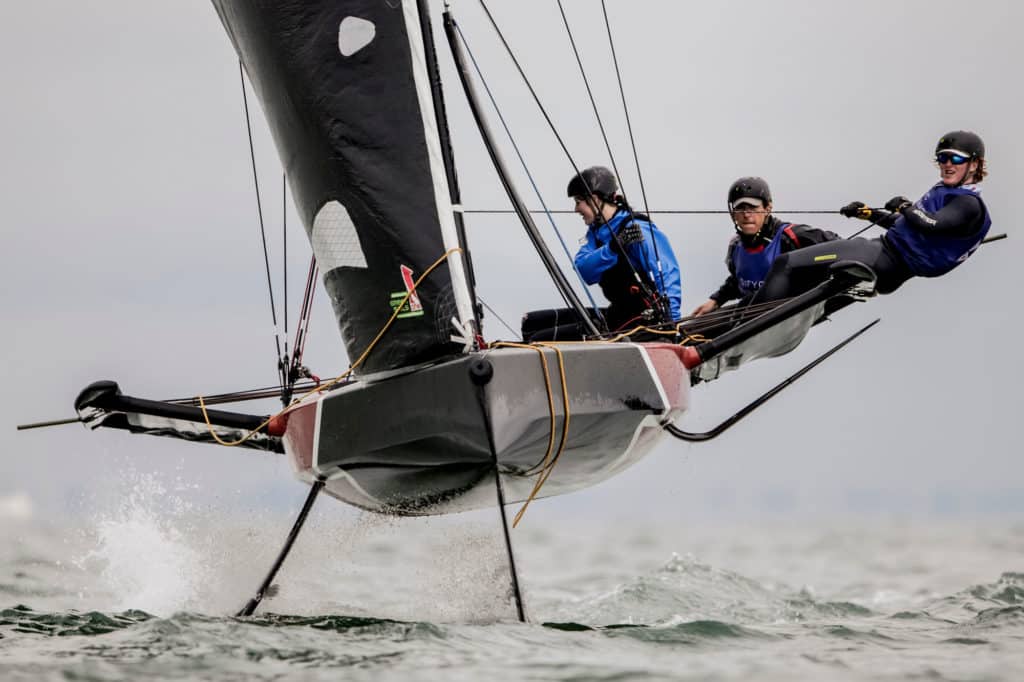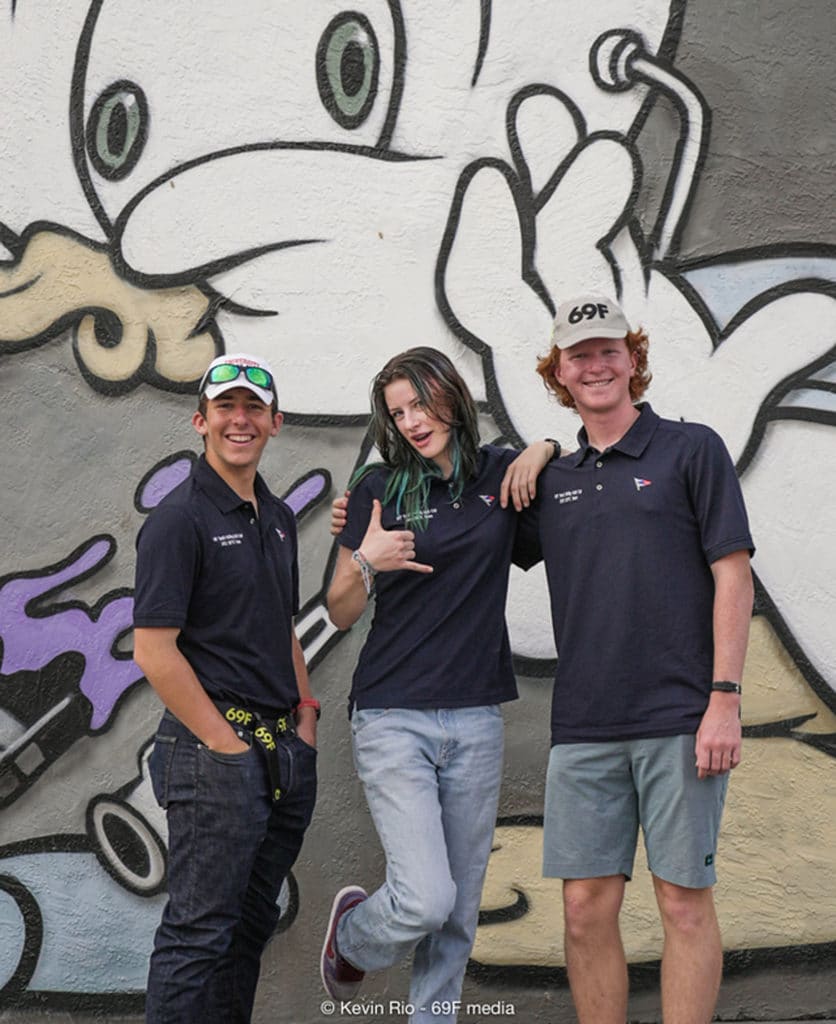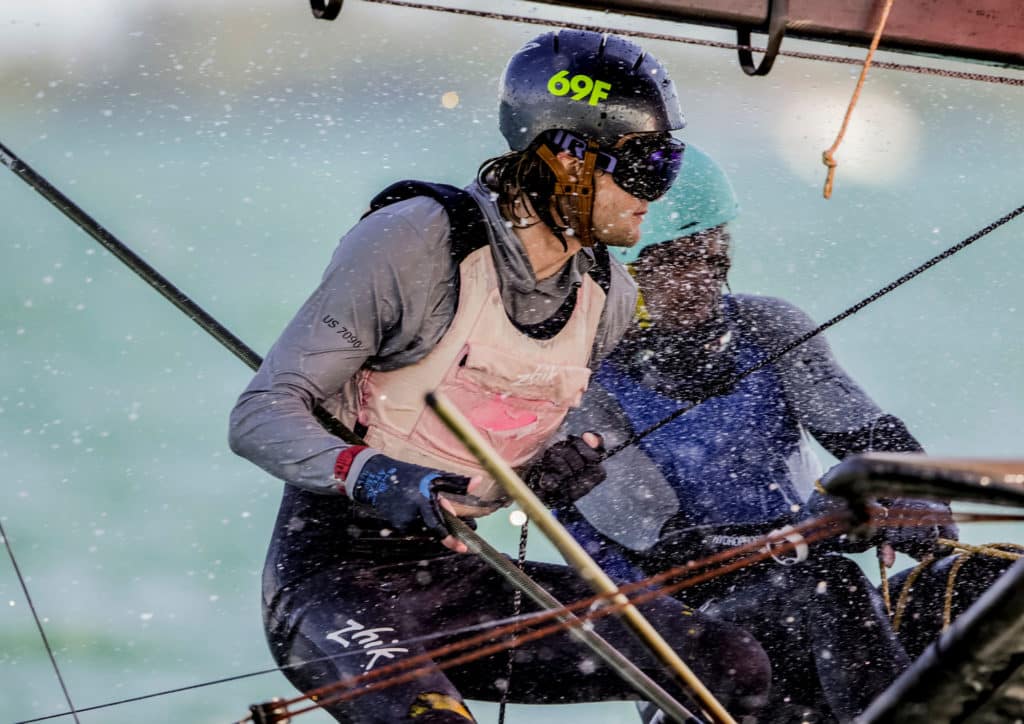
The first event in US waters for the Persico 69F Youth Foiling Gold Cup international circuit attracted little attention, perhaps because its outreach depended almost entirely on cryptic social media. But in the end, Team Argentina came out on top in the kickoff. Nacra 17 Olympians Dante Cittadini and Teresa Romairone were joined by Marcos Fernandez, twenty-somethings setting a standard for what it takes to win. Among US hopefuls, Team Sail America was skippered by University of Rhode Island’s Henry Lee. Arthur Serra, of San Francisco, California skippered Team StFYC, representing St. Francis Yacht Club’s high school program. Also traveling east to race was StFYC high school senior Declan Donovan driving Team Thailand. US sailors represented development efforts, looking for first experiences and thrills. Donovan survived to the Finals. He and Serra share their stories here, adapted by permission from the St. Francis YC’s Mainsheet newsletter, published in March 2022.
Can’t Wait
By Arthur Serra
Last fall I saw an incredible boat on Instagram. It looked like a small AC75. It had a similar foil setup, with three big sails, and it was going fast. I poked around on the Internet until I found the Persico 69F. At the time, the St. Francis YC Junior Program sailed only Lasers because of COVID. I love the Laser, but it’s good for 4 knots upwind and 12 knots downwind. The boat on my screen was cranking upwind and downwind at 25 knots and reaching at 30. I was hooked.
I researched it whenever I had time and finally got an email address for somebody from the class association. After four months of emailing them every week I got the reply I was looking for. “There’ll be boats in Miami starting in January; come sail them by yourself or with a buddy.”
I was elated and invited my good friend and fellow junior sailor Caspar Lenz Anderson to come along. Our last week of Christmas break, on the first day of the new year, we flew out of SFO and arrived in MIA. The day after, we went out to sail the boats and break our personal speed records. We showed up an hour early. We were so excited we couldn’t help ourselves. The instructors were surprised. The home office in Italy had communicated about two “kids” coming to sail. They expected beginners wanting joyrides. Instead, what greeted them were two 16-year-old, highly-energized racers ready to go. That changed their plans for how much sailing we would do.
First, our instructors gave us a lesson on the 69F. What makes these boats special are the V-shaped foils on either side. These are akin to AC75 foils and make the boat incredibly stable. Normally, only one of these V-foils is in the water, and they produce not only upward lift, but also massive righting moment. The V-foils counter the force to leeward generated by the sail. This makes the boat want to stay flat (as compared to a Moth or Waszp, which constantly want to capsize under an overpowered rig). With so much righting moment, sails can be bigger, so the boat accelerates faster and foils sooner.
There are three positions: skipper, mainsheet trimmer and flight controller. While adjusting the rake of the foils to manage the ride height, the flight controller also works with the skipper on tactics and focuses on the gennaker when sailing downwind, watching for puffs and lulls. The mainsheet trimmer has one job, and it’s in the name. All the main trimmer does is trim, except when jibing. The boat needs to sail as flat as possible at all times. Even a slight leeward heel in a small puff can cause the boat to capsize, so the trim has to be on point. Of course, the other way to manage heel is by changing the angle to the wind. That’s where the skipper comes into play. The skipper’s job is the same as on any boat: drive, play the angles, and keep everyone working together.
We rigged the boats, launched and towed out. The boats are simple once you get a good look. There’s a large self-tacking jib, a huge main trimmed from the boom, and a big kite with a retrieval line. The controls, sails and most of the normal sailing aspects are like a 49er’s. What’s different are the foils. Both the centerboard and the rudder are T-foils, recognizable to anybody who’s seen a foiling Moth.
The V-foils, which descend at forty-five-degree angles from either side of the hull, are dropped and lifted during tacks and jibes. The V-foils and the rudder foil rake are adjusted using lines that lead to the front of the boat, and these are adjusted by the flight controller to initiate foiling and maintain proper height. Because a trapeze can be dangerous, and this class is all about safety, the 69F instead has hull extensions, “hiking racks,” where crew members sit outboard. Over the next four days, we learned how to foil, twice raising our personal speed records out of the high teens. Now it’s 28 knots. Going that fast the boat feels light and playful. It’s a heady experience.
We started as flight controllers before moving on to skippering and mainsheet trimming. We worked hard on communication. Never before had we sailed a boat where skipper and trimmer need to be in sync to the point that even a momentary lack of concentration leads, at best, to falling off the foils and, at worst, to a capsize. By the second day, Caspar preferred trimming and I preferred driving, so we spent the next two days like that and became really synchronized. Our jibes and tacks weren’t perfect, but we could keep the boat going fast in a straight line. The first three days we zipped around Biscayne Bay, blasting past Hobies.
The fourth day lacked wind, so we went to the ocean to catch more breeze. We got the boat ripping, but to make our flight back to San Francisco we had to foil home through the shipping channel. We asked for permission from the Coast Guard but forgot to check with the harbor police, so when this strange contraption came flying into a busy channel, a high-speed chase ensued. We gave ourselves up. The police pulled us over. Luckily, it mattered when we told them the Coast Guard had given us permission. After all, they have bigger guns.

Now it can be told: We got stopped for sailing too fast. How cool is that?
The 69F is sailed in the Youth Foiling Gold Cup, a world tour Grand Prix series – think SailGP for under 25s. The first “act” of the 2022 Cup was in Miami, and we were there because the instructors on our second day made an offer we couldn’t refuse. Come back in February, they said. Come back and race. They knew we were hungry for more, and a team from the Bahamas had dropped out. We jumped on it and quickly added Sydney Lange, another member of the StFYC Junior program, to manage flight control. Caspar continued as mainsheet trimmer, and I skippered. Together, we represented St. Francis Yacht Club, competing against eight other teams – including another representing St. Francis with Declan Donovan driving.
We gave it our all and coming back from Miami after our loss there are feelings of disappointment, but honestly, I’m inspired. We raced against some of the best youth sailors, and seeing them absolutely destroy me shows the work I have ahead. I can’t wait.
Going for the Goals
By Declan Donovan
I had never sailed a 69F, but there I was, skippering Team Thailand and representing StFYC at Act 1 of the Youth Foiling Gold Cup. My teammates were Dylan Whitcraft, our main trimmer from Thailand, and Ella Beauregard, flight controller. Of the three, Dylan was the only one who had previous experience in this fast, foiling boat. We faced a major learning curve. Fortunately, the format of the 69F YFGC Series provides practice time ahead of the regatta. Unfortunately, our two practice days were not optimal. Mother Nature turned Biscayne Bay into a light wind lake. But let’s consider the format first.

Two days of practice were followed by three days of racing to determine qualifiers for the finals. Qualifying teams then moved on to knockout rounds. In total, my team had five days before the knockout series to learn the boat. First, we learned that a 69F can foil in very light conditions. However, picking the right puff to levitate onto the foils—and then pumping hard enough to maintain flight—is a hard move to time right, and it’s even harder to maintain flight. Trimmer and flight controller both have to constantly roll and press to maintain speed (class rules permit this) and the three of us switched positions frequently for the sake of recovery. We didn’t get much time on-foil before racing began.
I’m at home in the strong winds of San Francisco Bay, so when a squall suddenly brought the wind to 18 knots at the first start of the first day of competition, I was excited. We were on a reaching start to a quadrilateral course in a boat capable of 30 knots and I had about 30 minutes of solid foiling under my belt. What could possibly go wrong? Well …
First, we narrowly averted a collision with a boat capsized to leeward. Then came a gust we weren’t ready for and the discovery that going from 25 knots to zero is an abrupt change. Our flight controller, Ella, performed her next two maneuvers to perfection. First, she went flying out of the boat. Then she popped back aboard, declared “I’m good!” and we were back in the race.
Considerably older and wiser after three days of knockout rounds, we found ourselves in fourth place, qualified to continue to the finals. A win late in the day placed us in second but—and it was a big but.
On the last day, the breeze lightened again. We remained competitive but struggled in the starts. We made a few mistakes in maneuvers, and our inadequate batten tension was really “messed up” in the words of our friends from the Royal New Zealand Yacht Squadron. That said, the day had its triumphs: We clocked the fastest daily speed at 26 knots, improved our coordination during tacks and completed a foiling jibe. We had arrived in Miami with a plan to learn as much as we could about the 69F and how to race it, with a goal of setting ourselves up for Act 3 in Newport, Rhode Island, this July. We came away knowing we had exceeded our expectations.









